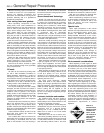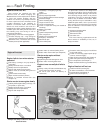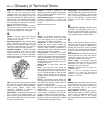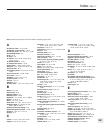
Engine fails to turn when starter
operated
ⅥⅥ Flat battery (recharge use jump leads or
push start)
ⅥⅥ Battery terminals loose or corroded
ⅥⅥ Battery earth to body defective
ⅥⅥ Engine earth strap loose or broken
ⅥⅥ Starter motor (or solenoid) wiring loose or
broken
ⅥⅥ Ignition/starter switch faulty
ⅥⅥ Major mechanical failure (seizure)
ⅥⅥ Starter or solenoid internal fault (see
Chapter 12)
Starter motor turns engine slowly
ⅥⅥ Partially discharged battery (recharge, use
jump leads, or push start)
ⅥⅥ Battery terminals loose or corroded
ⅥⅥ Battery earth to body defective
ⅥⅥ Engine earth strap loose
ⅥⅥ Starter motor (or solenoid) wiring loose
ⅥⅥ Starter motor internal fault (see Chapter 9)
Starter motor spins without
turning engine
ⅥⅥ Flywheel gear teeth damaged or worn
ⅥⅥ Starter motor mounting bolts loose
Engine turns normally but fails to
start
ⅥⅥ Damp or dirty HT leads and distributor cap
(crank engine and check for spark)
ⅥⅥ No fuel in tank (check for delivery at
carburettor)
ⅥⅥ Excessive choke (hot engine) or insufficient
choke (cold engine)
ⅥⅥ Fouled or incorrectly gapped spark plugs
(remove, clean and regap)
ⅥⅥ Other ignition system fault (see Chapter 4)
ⅥⅥ Other fuel system fault (see Chapter 3)
ⅥⅥ Poor compression (see Chapter 1)
ⅥⅥ Major mechanical failure (eg camshaft drive)
Engine fires but will not run
ⅥⅥ Insufficient choke (cold engine)
ⅥⅥ Air leaks at carburettor or inlet manifold
ⅥⅥ Fuel starvation (see Chapter 3)
ⅥⅥ Ignition fault (see Chapter 4)
Engine will not start
REF•10 Fault Finding
Spares and tool kit
Most vehicles are supplied only with
sufficient tools for wheel changing; the
Maintenance and minor repair tool kit detailed
in Tools and working facilities, with the
addition of a hammer, is probably sufficient
for those repairs that most motorists would
consider attempting at the roadside. In
addition a few items which can be fitted
without too much trouble in the event of a
breakdown should be carried. Experience and
available space will modify the list below, but
the following may save having to call on
professional assistance:
ⅥⅥ Spark plugs, clean and correctly gapped
ⅥⅥ HT lead and plug cap – long enough to
reach the plug furthest from the distributor
ⅥⅥ Distributor rotor, condenser and contact
breaker points (where applicable)
ⅥⅥ Drivebelt(s) — emergency type may
suffice
ⅥⅥ Spare fuses
ⅥⅥ Set of principal light bulbs
ⅥⅥ Tin of radiator sealer and hose bandage
ⅥⅥ Exhaust bandage
ⅥⅥ Roll of insulating tape
ⅥⅥ Length of soft iron wire
ⅥⅥ Length of electrical flex
ⅥⅥ Torch or inspection lamp (can double as
test lamp)
ⅥⅥ Battery jump leads
ⅥⅥ Tow-rope
ⅥⅥ Ignition waterproofing aerosol
ⅥⅥ Litre of engine oil
ⅥⅥ Sealed can of hydraulic fluid
ⅥⅥ Emergency windscreen
ⅥⅥ Wormdrive clips
ⅥⅥ Tube of filler paste
If spare fuel is carried, a can designed for
the purpose should be used to minimise risks
of leakage and collision damage. A first aid kit
and a warning triangle, whilst not at present
compulsory in the UK, are obviously sensible
items to carry in addition to the above. When
touring abroad it may be advisable to carry
additional spares which, even if you cannot fit
them yourself, could save having to wait while
parts are obtained. The items below may be
worth considering:
ⅥⅥ Clutch and throttle cables
ⅥⅥ Cylinder head gasket
ⅥⅥ Alternator brushes
ⅥⅥ Tyre valve core
One of the motoring organisations will be
able to advise on availability of fuel, etc, in
foreign countries.
A simple test lamp is useful for checking
electrical faults
Carrying a few spares may save you a long walk!


















